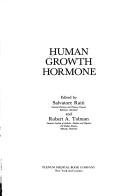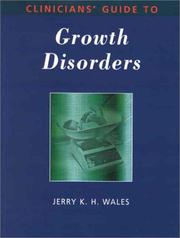| Listing 1 - 10 of 83 | << page >> |
Sort by
|
Book
Abstract | Keywords | Export | Availability | Bookmark
 Loading...
Loading...Choose an application
- Reference Manager
- EndNote
- RefWorks (Direct export to RefWorks)
The first two years of life represent a transition period when growth changes from predominantly growth hormone (GH) independent to GH dependent. This book, Growth Disorders and Acromegaly, includes two parts. The first part consists of five chapters that illustrate the nature, causes, types, signs, and symptoms of GH deficiency (GHD) and fetal growth restriction. It describes the impact of GH and its deficiency on different biological systems in children and adults. Also, this book assesses the role of human GH (hGH) and insulin-growth factor1 (IGF-1) gene families during pregnancy. This book offers several novel insights of GH in male reproductive health. The second part consists of three chapters that show the pegvisomant, colorectal neoplasms in acromegaly, epidemiology and underlying mechanisms, and the surgical managements of acromegaly. Finally, this book will be of interest to scientists, embryologists, neuroendocrinologists, neurotoxicologists, and physicians who follow recent developments in the field of growth disorders.
Book
Year: 2017 Publisher: London : National Institute for Health and Care Excellence,
Abstract | Keywords | Export | Availability | Bookmark
 Loading...
Loading...Choose an application
- Reference Manager
- EndNote
- RefWorks (Direct export to RefWorks)
The term 'faltering growth' (previously called 'failure to thrive') is widely used to refer to a slower rate of weight gain in childhood than expected for age and sex. The term faltering growth is preferred as periods of slow growth may represent temporary variation from the expected pattern and the word 'failure' may be seen as pejorative. Various definitions of faltering growth have been used in the past, meaning estimates of prevalence in the UK vary widely. This guideline covers recognition, assessment and monitoring of faltering growth in infants and children. It includes a definition of growth thresholds for concern and identifying the risk factors for, and possible causes of, faltering growth. It also covers interventions, when to refer, service design, and information and support.
Book
Year: 2017 Publisher: London : National Institute for Health and Care Excellence,
Abstract | Keywords | Export | Availability | Bookmark
 Loading...
Loading...Choose an application
- Reference Manager
- EndNote
- RefWorks (Direct export to RefWorks)
The term 'faltering growth' (previously called 'failure to thrive') is widely used to refer to a slower rate of weight gain in childhood than expected for age and sex. The term faltering growth is preferred as periods of slow growth may represent temporary variation from the expected pattern and the word 'failure' may be seen as pejorative. Various definitions of faltering growth have been used in the past, meaning estimates of prevalence in the UK vary widely. This guideline covers recognition, assessment and monitoring of faltering growth in infants and children. It includes a definition of growth thresholds for concern and identifying the risk factors for, and possible causes of, faltering growth. It also covers interventions, when to refer, service design, and information and support.
Book
Abstract | Keywords | Export | Availability | Bookmark
 Loading...
Loading...Choose an application
- Reference Manager
- EndNote
- RefWorks (Direct export to RefWorks)
Book
ISBN: 1838805842 1838805834 Year: 2020 Publisher: London, England : IntechOpen,
Abstract | Keywords | Export | Availability | Bookmark
 Loading...
Loading...Choose an application
- Reference Manager
- EndNote
- RefWorks (Direct export to RefWorks)
Growth disorders. --- Metabolism --- Disorders
Book
Abstract | Keywords | Export | Availability | Bookmark
 Loading...
Loading...Choose an application
- Reference Manager
- EndNote
- RefWorks (Direct export to RefWorks)

ISBN: 0306420538 1461572037 1461572010 Year: 1986 Publisher: New York
Abstract | Keywords | Export | Availability | Bookmark
 Loading...
Loading...Choose an application
- Reference Manager
- EndNote
- RefWorks (Direct export to RefWorks)
Pathological endocrinology --- Paediatrics --- Growth disorders. --- Somatomedin. --- Somatostatin. --- Somatotropin. --- Growth Disorders.

ISBN: 0340762373 9780340762370 Year: 2002 Publisher: London: Edward Arnold,
Abstract | Keywords | Export | Availability | Bookmark
 Loading...
Loading...Choose an application
- Reference Manager
- EndNote
- RefWorks (Direct export to RefWorks)
Growth Disorders --- Growth --- Child --- Adolescent --- Growth disorders --- Children --- Teenagers
Book
ISBN: 9782704010875 2704010870 Year: 2000 Publisher: Paris: Doin,
Abstract | Keywords | Export | Availability | Bookmark
 Loading...
Loading...Choose an application
- Reference Manager
- EndNote
- RefWorks (Direct export to RefWorks)
Book
Abstract | Keywords | Export | Availability | Bookmark
 Loading...
Loading...Choose an application
- Reference Manager
- EndNote
- RefWorks (Direct export to RefWorks)
GROWTH DISORDERS --- GROWTH HORMONE --- Acromegaly
| Listing 1 - 10 of 83 | << page >> |
Sort by
|

 Search
Search Feedback
Feedback About UniCat
About UniCat  Help
Help News
News